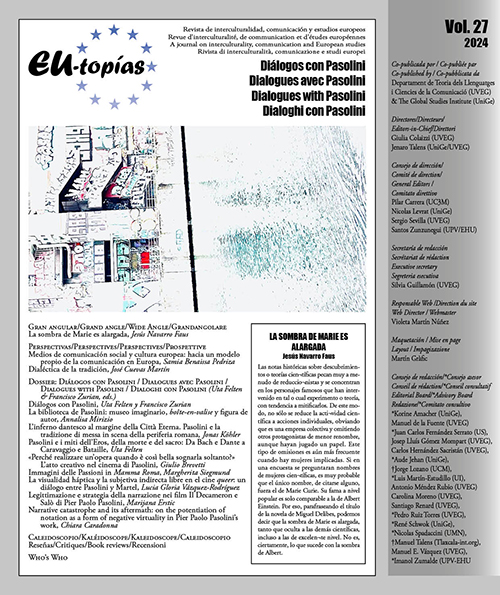Paolo Pasolini Legitimisation and strategy of narration in Pier Paolo Pasolini’s films Il Decameron and Salò
DOI:
https://doi.org/10.7203/eutopias.27.28625Keywords:
Giovanni Boccaccio, Pier Paolo Pasolini, Decameron, Salò. Abstract
Abstract
Pier Paolo Pasolini’s works are intellectual milestones of the 20th century. His Trilogia della vita and the unfinished Trilogia della morte provide insights into the elementary situations of human existence such as love, sexuality, but also death, danger, and the torments of the concentration camps of the 20th century. Time and again, they also sharpen our view of the current situation. In the spirit of Pier Paolo Pasolini, this essay has a well-known reason: at the beginning of the Covid pandemic, Giovanni Boccaccio’s Decameron was frequently quoted alongside Camus’ novel The Stranger. Pier Paolo Pasolini created an update of the Italian classic in 1971, and it is this film that I will focus on below. I will try to find out how the legitimization of Boccaccio’s narrative is transformed in Pasolini’s film Decameron. Pasolini’s film Salò serves as a counterpoint to Decameron, which I will deal with in the last part of the essay. The aim of the essay is an analysis of the strategies of narrative legitimation in Boccaccio, which are placed in the context of Pasolini’s film narration.
 Downloads
Downloads
 References
References
Boccaccio, Giovanni. Decameron. Vol 1–2. A cura di Vittore Branca. Milano: Mondadori 2005.
Borsò, Vittoria. «Pasolinis Decameron oder eine kinematographische ‹Divina Mimesis› – Mediale Schwellen zwischen Malerei und Film». Borsò: Das Adere denken, schreiben, sehen: Schriften zur romanistischen Kulturwissenschaft. A cura di Heike Brohm, Vera Elisabeth Gerling, Björn Goldammer e Beatrice Schuchardt. Bielefeld: trascript 2008, pp. 233–260.
Chiancone-Schneider, Donatella. «Kino, Tanz und Malerei im Film: La ricotta von Pier Paolo Pasolini». Pasolini intermedial. A cura di Uta Felten, Kristin Mlynek-Theil e Franziska Andraschik. Francoforte sul Meno e altri: Peter Lang 2014, pp. 107–129 [Romania viva, 13].
Cuevas, Miguel Ángel. «Il Decameron di Pasolini: manipulación de ‹autor›». Pasolini intermedial. A cura di Uta Felten, Kristin Mlynek-Theil e Franziska Andraschik. Francoforte sul Meno e altri: Peter Lang 2014, pp. 159–166 [Romania viva, 13].
Didi-Huberman, Georges. Das Überleben der Glühwürmchen. Monaco di Baviera: Fink Verlag 2012.
Ebner, Christiane. Amore per la letteratura – Passione per il cinema. Eine medienkomparatistische Untersuchung zu Sandro Veronesis Romanwerk. Berlino: LIT Verlag 2013.
Erstić, Marijana. Ein Jahrhundert der Verunsicherung. Medienkomparatistische Analysen. Siegen: Universitätsverlag UniverSi 2017.
Erstić, Marijana. «La maniera di Pier Paolo Pasolini. Bildtradition und Nachkriegszeit». Horizonte. Neue Serie. Italianistische Zeitschrift für Kulturwissenschaft und Gegenwartsliteratur/Horizonte. Nuova serie. Rivista d’Italianistica e di letteratura contemporanea, 3 (2018), pp. 157–171.
Erstić, Marijana / Antonela Marić. «Animals and Animality in Pasolin’s Films: La ricotta and Uccellacci e uccellini». Lingua Montenegrina, 32 (2023), 2, pp. 263–282.
Felten, Uta / Kristin Mlynek-Theil / Franziska Andraschik (a cura di). Pasolini intermedial. Francoforte sul Meno e altri: Peter Lang 2014 [Romania viva, 13].
Groß, Bernhard. Pier Paolo Pasolini. Figurationen des Sprechens. Berlino: Vorwerk 8, 2008.
Herklotz, Ingo. «Pier Paolo Pasolinis Decameron (1971). Ein cinematographischer Beitrag zur Kulturkritik». 700 Jahre Boccaccio. Traditionslinien vom Trecento bis in die Moderne. A cura di Christa Bertelsmeier-Kierst e Rainer Stillers. Francoforte sul Meno e altri: Peter Lang 2015, pp. 269–306 [Kulturgeschichtliche Beiträge zum Mittelalter und der frühen Neuzeit, 7].
Jahraus, Oliver. «Salò oder die 120 Tage von Sodom. Zwischen Skandalfilm und Gesellschaftsdiagnose». Pasolini – Haneke. Filmische Ordnungen von Gewalt. Navigationen. Zeitschrift für Medien und Kulturwissenschaft, 14 (2014), 1, pp. 23–34.
Kriesel, James C. «Boccaccio and the Early Modern Reception of Tragedy». Renaissance Quarterly, 69 (2016), 2, 2016, pp. 415–448. JSTOR, https://www.jstor.org/stable/26559781 [15.04.2024].
Marcus, Millicent. «Cross-Fertilizations: Folklore and Literature in Decameron 4,5.» Italica, 66 (1989), 4, pp. 383–398. JSTOR, https://doi.org/10.2307/479252 [15.04.2024].
Pasolini, Pier Paolo. «L’articolo delle lucciole». Pasolini: Scritti corsari. Milano: Garzanti 1977, pp. 156–164.
Paul, Konrad / Hans J. Wulff. «Mehrfachkodierungen, Fragmentierungen oder multiple ästhetische Ordnungen». Pasolini – Haneke. Filmische Ordnungen von Gewalt. Navigationen. Zeitschrift für Medien und Kulturwissenschaft, 14 (2014), 1, pp. 13–21.
Prinzler, Hans Helmut / Wolfgang Schütte (a cura di). Pier Paolo Pasolini. Monaco di Baviera: Carl Hanser Verlag 1977 [Reihe Film 12].
Reck, Hans Ulrich. Pier Paolo Pasolini. Monaco di Baviera: Fink Verlag 2010.
Schwaderer, Richard. Idillio campestre. Ein Kulturmodell in der italienischen Erzählliteratur des 19. Jahrhunderts. Monaco di Baviera: Fink Verlag 1987.
Vattimo, Gianni / Aldo Rovatti. Il pensiero debole. Milano: Feltrinelli 2010.
Filmografia
Mamma Roma. Italia 1962 Reg.: Pier Paolo Pasolini.
Le streghe. Italia / Francia 1967. Reg.: Mauro Bolognini, Pier Paolo Pasolini, Franco Rossi, Vittorio de Sica, Luchino Visconti.
Il Decameron. Italia 1971. Reg.: Pier Paolo Pasolini.
Salò o le 120 giornate di Sodoma. Italia 1975. Reg.: Pier Paolo Pasolini.
Downloads
Published
How to Cite
-
Abstract122
-
PDF 34
Issue
Section
License
![]()
The authors conserve the copyright. All content published in EU-topías. Journal of interculturality, Communication, and European Studies are subject to the license Creative Commons Attribution-NonCommercial-ShareAlike 4.0 license. The full text of the license can be found at <http://creativecommons.org/licenses/by-nc-sa/4.0>
They may be copied, used, disseminated, transmitted and publicly displayed, provided that:
- The authorship and original source of the publication is cited (journal, publisher and URL of the work).
- They are not used for commercial purposes.
- The existence and specifications of this license of use are mentioned.
It is the responsibility of the authors to obtain the necessary permissions for images that are subject to copyright.



